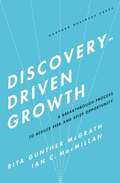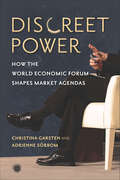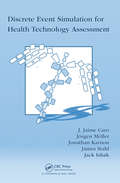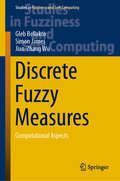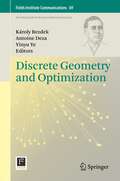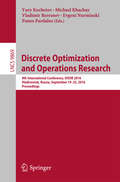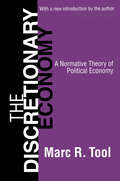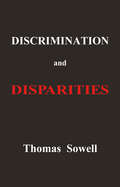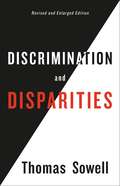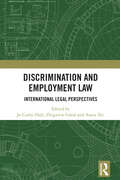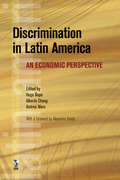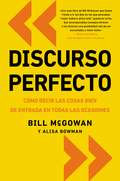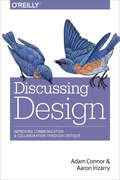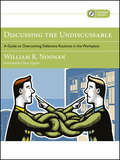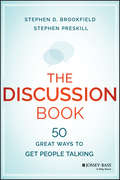- Table View
- List View
Discovering Your Career
by Ann K. Jordan Lynne T. WhaleyIn a unique approach to career planning, Discovering Your Career matches a career area to the student rather than the student to a career area. This approach focuses on each student's needs and guides the student to pursuing a career based on individual talents and passions. Discovering Your Career addresses current career trends related to technology, workforce diversity, and global markets; explores investigating careers via job shadowing, service learning, and community mentoring; explains and discusses a variety of career and educational options; and emphasizes self-awareness, goal setting, decision making, reduction of prejudice, SCANS competencies, and economic responsibility. Discovering Your Career also promotes future career success by providing students with current and projected career information and by helping them build skills in such vital areas as networking, teamwork, communication, and problem solving.
Discovery-Driven Growth
by Rita Gunther Mcgrath Ian C. MacmillanYou've been charged with growing your business. Incremental growth can no longer deliver the results you need. You need truly dynamic growth - and you need to achieve it without risking a hugely expensive gamble. How can you encourage innovative new ventures and pursue ambitious growth while minimizing risk?In Discovery-Driven Growth, authors McGrath and MacMillan show how companies can plan and pursue an aggressive growth agenda with confidence. By carefully framing their strategic growth opportunities, testing each project assumption against a series of checkpoints, and creating a culture that acts on evidence and learning instead of blind stumbling, companies can better control their costs, minimize surprises, and know when to disengage from questionable projects--before it's too late.Providing tools that will help you select and better assess the potential of any strategic venture, from new product lines to entirely new businesses, the authors outline a comprehensive process that lets you identify, manage, and leverage your company's full portfolio of opportunities. By reducing up-front costs and eliminating unnecessary risks, you'll be able to avoid missteps and explore more options to create the breakthrough growth that your business requires.
Discovery-Driven Planning
by Ian C. Macmillan Rita Gunther McgrathSmart companies may incur huge losses when they enter unknown territory--new alliances, markets, products, technologies. Failures could be prevented or their cost contained if managers approached innovative ventures with the right planning and control tools. Discovery-driven planning is a practical tool that acknowledges the difference between planning for a new venture and for a more conventional business. Using Kao Corp.'s entry into floppy disks, the authors present a step-by-step approach to help companies think differently about planning. Managers should begin with the bottom line and work their way up the income statement, first determining a new venture's profit potential.
Discovery Limited
by Michael E. Porter Mark R. Kramer Aldo SesiaDiscovery Ltd. is a South-African based insurance company. Started in the early 1990s, Discovery used behavioral economics and data collection to innovate in the health care insurance industry. Its founder Adrian Gore believed that the company's products needed to not only make money but have a positive impact on society. Using its Vitality Wellness program as its strategic lynchpin, Discovery expanded into other insurance areas and financial services products and also entered new markets abroad. In late 2014, Gore and his team had to decide how to further develop the company and prioritize among many growth opportunities.
Discovery Skill #1: Associating-How Making Connections Across Seemingly Unrelated Fields and Disciplines Triggers Your Innovative Powers
by Hal B. Gregersen Jeffrey H. Dyer Clayton M. ChristensenWhen it comes to disruptive innovation, you don't have to start from scratch to create something new. Asking questions and fusing knowledge across disciplines and industries are the keys to improving your aptitude for association, a cognitive skill that lies at the core of innovation. In this chapter, authors Jeff Dyer, Hal Gregersen, and Clayton Christensen teach you how to strengthen your capacity for associating by describing how companies such as Oracle and Starbucks and devices such as the BlackBerry are in fact the products of association. "Defocusing," "Lego thinking," and "curiosity boxes" are just some of the practical strategies and activities designed to help you develop the associating skills that could lead to your own breakthrough innovation. This chapter was originally published as Chapter 2 of "The Innovator's DNA: Mastering the Five Skills of Disruptive Innovators."
Discovery Skill #2: Questioning-How Inquisitive Thinking and Provocative Questions Spark Innovation
by Hal B. Gregersen Jeffrey H. Dyer Clayton M. ChristensenWe tell children that there is no such thing as a dumb question, but so often we keep our ideas and concerns to ourselves, afraid to come across as foolish or disagreeable. But when you stifle your creative imagination, you limit your opportunities for innovation. In this chapter, authors Jeff Dyer, Hal Gregersen, and Clayton Christensen encourage you to channel your inner child and rediscover your spirit of curiosity. They explain how asking different and provocative questions allows you to reframe problems and uncover new and better solutions, and how questioning can be used as the creative catalyst for innovation. Along with techniques like "QuestionStorming," this chapter provides question sequences that promise to launch your inquisitive thinking in a productive direction. By pondering what might be instead of dwelling on what is, you can free yourself from the shackles of routine and stumble upon something altogether novel. This chapter was originally published as Chapter 3 of "The Innovator's DNA: Mastering the Five Skills of Disruptive Innovators."
Discovery Skill #3: Observing-How Watching Your Customers, Other Companies, and the World Around You Can Lead to Game-Changing Innovation
by Hal B. Gregersen Jeffrey H. Dyer Clayton M. ChristensenDelivery-driven leaders often become so consumed by the pressures of running an organization that they never pause to take a look at what's going on around them. But disruptive innovators like Ratan Tata, creator of the Nano car, whose journey of discovery is described in this chapter, are constantly on the lookout for jobs people need to get done and workarounds, or partial solutions, that can be the answers to everyday problems. In this chapter, authors Jeff Dyer, Hal Gregerson, and Clayton Christensen advise you to expand your perspective by using your peripheral vision. They show you how observing your environment can bring great insight. Also in this chapter, they detail three habits that will make you a good observer: 1) Actively watching customers to see what products they "hire" to do what jobs; 2) Learning to look for surprises or anomalies; and 3) Finding opportunities to observe in a new environment. This chapter was originally published as Chapter 4 of "The Innovator's DNA: Mastering the Five Skills of Disruptive Innovators."
Discovery Skill #4: Networking-How Interacting with People Outside Your Social and Professional Spheres Can Jump-Start Innovation
by Hal B. Gregersen Jeffrey H. Dyer Clayton M. ChristensenThinking outside the box is just one component of disruptive innovation. Venturing outside your social circle is equally important. Diversifying your personal and professional contacts will spark an inundation of new knowledge and fresh perspectives that can stimulate innovative ideas. In this chapter, authors Jeff Dyer, Hal Gregerson, and Clayton Christensen elaborate on the benefits of networking with people and companies outside your area of expertise. The chapter is packed with examples of crossovers that have yielded incredible success, like Coca Cola's surprising influence on the design of the BlackBerry. Whether at a formal idea-networking event or a casual backyard barbecue, innovators are always learning from the people around them. Equipped with the tips featured at the end of this chapter, you will be able to instigate new and stimulating social interactions and, in the process, break new ground for your business. This chapter was originally published as Chapter 5 of "The Innovator's DNA: Mastering the Five Skills of Disruptive Innovators."
Discovery Skill #5: Experimenting-How Your Willingness to Try New Things, Take Something Apart, or Build a Prototype Boosts Your Power to Innovate
by Hal B. Gregersen Jeffrey H. Dyer Clayton M. ChristensenForget the lab coat, the Petri dish, and all those hazardous chemicals. Innovators can experiment everywhere, everyday, with whatever materials they have at hand. In this chapter, authors Jeff Dyer, Hal Gregerson, and Clayton Christensen discuss the many forms experimenting can take, from hands-on tinkering to hypothetical musings, and narrow them down to three styles for approaching the process yourself. The best part of this discovery skill is that failure is not an option! Any experiment produces feedback that can lead to today's discovery or be stored for a future innovation. This chapter is filled with stories about the experimental beginnings of companies like Amazon, Dell, and IKEA, plus quantitative data that support the direct link between experimentation and innovation. Taking you from the toy box to the junkyard, this chapter concludes with simple, fun activities that will help you develop the experimental mind-set of an innovator. This chapter was originally published as Chapter 6 of "The Innovator's DNA: Mastering the Five Skills of Disruptive Innovators."
Discreet Power: How the World Economic Forum Shapes Market Agendas (Emerging Frontiers in the Global Economy)
by Christina Garsten Adrienne SörbomIn Discreet Power, Christina Garsten and Adrienne Sörbom undertake an ethnographic study of the World Economic Forum (WEF). Accessing one of the primary agenda-setting organizations of our day, they draw on interviews and participant observation to examine how the WEF wields its influence. They situate the WEF within an emerging system of "discretionary governance," in which actors craft ideas and entice formal authorities and top leaders in order to garner significant sway. Yet in spite of its image as a powerful, exclusive brain trust, the WEF has no formal mandate to implement its positions. It must convince others to advance chosen causes and enact suggestions, rendering its position quite fragile. Garsten and Sörbom argue that the WEF must be viewed relationally as a brokering organization that lives between the market and political spheres and that extends its reach through associated individuals and groups.They place the WEF in the context of a broader shift, arguing that while this type of governance opens up novel ways of dealing with urgent global problems, it challenges core democratic values.
Discrete Event Simulation for Health Technology Assessment
by J. Jaime Caro Jörgen Möller Jonathan Karnon James Stahl Jack IshakThis is the first book to make all the central concepts of discrete event simulation relevant for health technology assessment. Accessible to beginners, the book requires no prerequisites and describes the concepts with as little jargon as possible. It presents essential concepts, a fully worked out implementation example, approaches to analyze the simulations, the development of the required equations, model verification techniques, and validation. The book also covers various special topics and includes a real case study involving screening strategies for breast cancer surveillance.
Discrete Fuzzy Measures: Computational Aspects (Studies in Fuzziness and Soft Computing #382)
by Gleb Beliakov Simon James Jian-Zhang WuThis book addresses computer scientists, IT specialists, mathematicians, knowledge engineers and programmers, who are engaged in research and practice of multicriteria decision making. Fuzzy measures, also known as capacities, allow one to combine degrees of preferences, support or fuzzy memberships into one representative value, taking into account interactions between the inputs. The notions of mutual reinforcement or redundancy are modeled explicitly through coefficients of fuzzy measures, and fuzzy integrals, such as the Choquet and Sugeno integrals combine the inputs. Building on previous monographs published by the authors and dealing with different aspects of aggregation, this book especially focuses on the Choquet and Sugeno integrals. It presents a number of new findings concerning computation of fuzzy measures, learning them from data and modeling interactions. The book does not require substantial mathematical background, as all the relevant notions are explained. It is intended as concise, timely and self-contained guide to the use of fuzzy measures in the field of multicriteria decision making.
Discrete Geometry and Optimization
by Antoine Deza Yinyu Ye Karoly BezdekOptimization has long been a source of both inspiration and applications for geometers, and conversely, discrete and convex geometry have provided the foundations for many optimization techniques, leading to a rich interplay between these subjects. The purpose of the Workshop on Discrete Geometry, the Conference on Discrete Geometry and Optimization, and the Workshop on Optimization, held in September 2011 at the Fields Institute, Toronto, was to further stimulate the interaction between geometers and optimizers. This volume reflects the interplay between these areas. The inspiring Fejes Tóth Lecture Series, delivered by Thomas Hales of the University of Pittsburgh, exemplified this approach. While these fields have recently witnessed a lot of activity and successes, many questions remain open. For example, Fields medalist Stephen Smale stated that the question of the existence of a strongly polynomial time algorithm for linear optimization is one of the most important unsolved problems at the beginning of the 21st century. The broad range of topics covered in this volume demonstrates the many recent and fruitful connections between different approaches, and features novel results and state-of-the-art surveys as well as open problems.
Discrete Optimization and Operations Research
by Yury Kochetov Michael Khachay Vladimir Beresnev Evgeni Nurminski Panos PardalosThis book constitutes the proceedings of the 9th International Conference on Discrete Optimization and Operations Research, DOOR 2016, held in Vladivostok, Russia, in September 2016. The 39 full papers presented in this volume were carefully reviewed and selected from 181 submissions. They were organized in topical sections named: discrete optimization; scheduling problems; facility location; mathematical programming; mathematical economics and games; applications of operational research; and short communications.
The Discretionary Economy: A Normative Theory of Political Economy
by Marc ToolThe Discretionary Economy argues that we do in fact control our own political and economic destinies. As a community, we have discretion over policies that determine whether an economic process adequately provides for the necessities of life. We also determine who participates in normative public judgments and whether decisions distinguish between what is and what ought to be. Tool argues that we must continuously organize the institutional structures through which economic and political functions in the social process are carried on. We must exercise discretion by creating and modifying institutions that coordinate our behavior.To exercise discretion effectively requires that we employ distinctively American economic, political, and philosophical theory. In this volume, the pivotal twentieth-century contributors to this encompassing theory of political economy are Thorstein Veblen, John Dewey, Clarence Ayres, and R. Fagg Foster. This volume presents, in detail, their analytical and philosophical perspective on social change. A major purpose of this volume is to compare and contrast the American tradition with the traditions of capitalism, Marxism, and fascism, demonstrating that the former can resolve compelling economic and political problems and the latter two cannot.This book explains how to identify and analyze social, economic, and political problems confronted in all communities, and how to go about framing and implementing structural adjustments in the political economy. It will be of interest to students in non-traditional courses in political economy including institutional economics, contemporary social problems, economics and social policy, methodology, and contemporary economic thought.
Discrimination and Disparities
by Thomas SowellAn empirical examination of how economic and other disparities ariseEconomic and other outcomes differ vastly among individuals, groups, and nations. Many explanations have been offered for the differences. Some believe that those with less fortunate outcomes are victims of genetics. Others believe that those who are less fortunate are victims of the more fortunate. Discrimination and Disparities gathers a wide array of empirical evidence from to challenge the idea that different economic outcomes can be explained by any one factor, be it discrimination, exploitation or genetics. It is readable enough for people with no prior knowledge of economics. Yet the empirical evidence with which it backs up its analysis spans the globe and challenges beliefs across the ideological spectrum. The point of Discrimination and Disparities is not to recommend some particular policy "fix" at the end, but to clarify why so many policy fixes have turned out to be counterproductive, and to expose some seemingly invincible fallacies--behind many counterproductive policies.
Discrimination and Disparities
by Thomas SowellAn enlarged edition of Thomas Sowell's brilliant examination of the origins of economic disparitiesEconomic and other outcomes differ vastly among individuals, groups, and nations. Many explanations have been offered for the differences. Some believe that those with less fortunate outcomes are victims of genetics. Others believe that those who are less fortunate are victims of the more fortunate.Discrimination and Disparities gathers a wide array of empirical evidence to challenge the idea that different economic outcomes can be explained by any one factor, be it discrimination, exploitation, or genetics. This revised and enlarged edition also analyzes the human consequences of the prevailing social vision of these disparities and the policies based on that vision--from educational disasters to widespread crime and violence.
Discrimination and Employment Law: International Legal Perspectives
by Jo Carby-Hall Zbigniew Góral Aneta TycPresenting the issues of discrimination in employment in a multifaceted manner, this book examines the standards on anti-discrimination law for employment at international and EU levels and those deriving from national jurisdictions. Bringing together top scholars in the field of anti-discrimination employment law, this book explains the conceptual and theoretical foundations of the principle of non-discrimination in employment and assesses the most significant changes to law and ongoing challenges in the Netherlands, Poland, Germany, the UK, Australia, New Zealand, Canada, India, Switzerland and Israel. Identifying emerging trends in anti-discrimination employment law, this book offers a comparative, problem-solving approach and an in-depth analysis of new developments in both anti-discrimination statutory law and case law. Addressing employment law with a focus on anti-discrimination law and human rights law, this book will be essential reading for students, academics and practitioners working in the fields of labour and employment law, anti-discrimination law and human rights law and offers an international comparative overview of the most up-to-date issues relating to discrimination.
Discrimination in Latin America: An Economic Perspective
by Alberto Chong Hugo Ñopo Andrea MoroWhile there is a strongly held belief that Latin American societies are highly discriminatory, the economic profession has found relatively little evidence for this perception, and until recently other social sciences had prevailed in the discussion of this timely and relevant topic. The development of new tools for analyzing the economic mechanisms underlying discrimination, however, has opened up several avenues for research. This book presents a set of studies on contemporary discrimination in Latin America that takes advantage of these new tools by focusing on social interactions that range from cooperation, group formation, and the impact of migration in poor families to specific markets such as housing and labor. The techniques applied include traditional regression analysis, experimental approaches, and audit studies, as well as structural methods. This wide range of analytical approaches leads to findings that confirm some of the common perceptions regarding discrimination but challenge the conventional wisdom in other regards In some instances the long-held conventional wisdom may not hold at all. Latin Americans do not discriminate more or less than inhabitants of other regions, and the discrimination that does occur appears largely to stem from lack of information on individuals-a result of great interest in colleges and universities that teach courses on Latin American development both at the undergraduate and graduate level. Furthermore, this book's findings extend to the political arena, as they challenge standard policies that have been ineffective for decades. Finally, this book should be of interest to researchers, as the empirical methods employed are at the vanguard of the profession. In fact, in addition to the contribution that this volume makes to the literature on discrimination, it also has the potential to contribute more broadly to labor economics, development economics and experimental economics, as well as to Latin American studies.
Discursive Constructions of Corporate Identities by Chinese Banks on Sina Weibo
by Wei FengThis book addresses the discursive construction of corporate identities in social media on the part of Chinese corporations, particularly highlighting how followers of corporate social media co-create corporate identities during firm-follower interactions. Toward this end, it pursues an integrated sociolinguistics approach combining e. g. thematic analysis, interactional analysis and in-depth interviews. Readers will also find extensive information on the brand-new dialogic framework of corporate identity formation. The book offers an insightful and revealing guide for both practitioners/trainers and teachers in corporate communication who are faced with the challenges of managing public relations and corporate images in the age of social media. It can also serve as a valuable case study for those readers who are fascinated by the Chinese economy and discourse analysis of the Chinese language.
Discurso perfecto: Cómo decir las cosas bien de entrada en
by Bill McgowanDecir lo correcto de la manera correcta puede hacer la diferencia entre sellar el acuerdo o la pérdida de la cuenta, obtener un ascenso, o conseguir una carta de despido. Es esencial tener un discurso perfecto- para obtener el mensaje correcto a la persona adecuada en el momento adecuado. En Discurso Perfecto, Bill McGowan muestra cómo elaborar el mensaje correcto y entregarlo utilizando el lenguaje verbal y no verbal adecuado. Discurso Perfecto te enseña cómo superar dificultades de comunicación comunes utilizando simples principios de McGowan de persuasión, que son muy eficaces y fáciles de aprender, implementar y dominar. Con Discurso Perfecto se puede aprovechar el poder de la persuasión y que la gente no sólo escuche atentamente a cada palabra, pero también la recuerde mucho tiempo después que has dejado la habitación.
Discussing Design: Improving Communication and Collaboration through Critique
by Adam Connor Aaron IrizarryReal critique has become a lost skill among collaborative teams today. Critique is intended to help teams strengthen their designs, products, and services, rather than be used to assert authority or push agendas under the guise of "feedback." In this practical guide, authors Adam Connor and Aaron Irizarry teach you techniques, tools, and a framework for helping members of your design team give and receive critique.Using firsthand stories and lessons from prominent figures in the design community, this book examines the good, the bad, and the ugly of feedback. Youâ??ll come away with tips, actionable insights, activities, and a cheat sheet for practicing critique as a part of your collaborative process.This book covers:Best practices (and anti-patterns) for giving and receiving critiqueCultural aspects that influence your ability to critique constructivelyWhen, how much, and how often to use critique in the creative processFacilitation techniques for making critiques timely and more effectiveStrategies for dealing with difficult people and challenging situations
Discussing the Undiscussable: A Guide to Overcoming Defensive Routines in the Workplace
by William R. NoonanSince his 1990 landmark book Overcoming Organizational Defenses, Chris Argyris has extensively researched and written about how well-meaning, smart people create vicious cycles of defensive behavior to protect themselves from embarrassment and threat. In Discussing the Undiscussable, Bill Noonan enlivens the scholarly work of Chris Argyris through the use of reflective exercises and easy-to-read chapters that illuminate the basic human experience endemic to the creation of defensive routines. This book offers hope for altering organizational defensive routines by leveraging the greatest opportunity for change--the way we think and act.Discussing the Undiscussable provides a set of practical "how to do" exercises for detecting, surfacing, and discussing organizational defensive routines in a safe and productive way. The combination of text, business fable, and interactive and reflective exercises is versatile in its application to both individuals and groups. The companion DVD contains video vignettes of the book's business fable where the actors model both defensive routines and virtuous cycles of behavior. Readers will instantly recognize what has long been going on in the workplace, and will be able to develop the skills to talk about it productively.
Discussion: Where Minds Meet
by Richard LueckeThis chapter emphasizes that coaching actively requires not only direct observation, but a thorough discussion of what was objectively observed during the preparation phase. This important step provides both parties, coach and subordinate, the opportunity to talk openly about both perspectives in an attempt to identify where help is needed. Together, they can decide how to proceed and where to make improvements.
The Discussion Book
by Stephen Preskill Stephen D. BrookfieldBuild teams, make better decisions, energize groups, and think out of the box Do you need a resource that you can pull out of your pocket to liven up meetings, trainings, professional development, and teaching? The fifty easily applied techniques in this timely manual spur creativity, stimulate energy, keep groups focused, and increase participation. Whether you're teaching classes, facilitating employee training, leading organizational or community meetings, furthering staff and professional development, guiding town halls, or working with congregations, The Discussion Book is your go-to guide for improving any group process. Each of the concrete techniques and exercises is clearly described with guidance on selection and implementation, as well as advice on which pitfalls to avoid. All of the techniques: Offer new ways to engage people and energize groups Get employees, students, colleagues, constituents, and community members to participate more fully in deliberative decision-making Encourage creativity and openness to new perspectives Increase collaboration and build cohesive teams Keep groups focused on important topics and hard-to-address issues Derived from the authors' decades of experience using these exercises with schools, colleges, corporations, the military, social movements, health care organizations, prisons, unions, non-profits, and elsewhere, The Discussion Book will help you guide discussions that matter.

